
CoastView - Beachy Head
On This Day in 29 October 1929: The purchase of Beachy Head
The Times, 29 October 1997
"The Corporation of Eastbourne now owns the whole of Beachy Head and 4,000 acres westwards and northwards..." and those who now walk over this splendid stretch of country can reflect that in buying it for Pounds 100,000 the corporation got a good bargain.
THE PURCHASE OF BEACHY HEAD (FROM OUR SPECIAL CORRESPONDENT) EASTBOURNE, Oct 29.
The Duke and Duchess of York took part to-day in the celebrations of the purchase by Eastbourne of Beachy Head and of many acres of down and farm land stretching away almost to Birling Gap, which are now saved for ever from building or other exploitation. The whole town and great crowds from many parts of Sussex assembled for the day's rejoicings. The town was beflagged wherever the Royal visitors went during their long day, and their passage through the streets was marked by the greatest enthusiasm.
The preservation of these Downs has cost the town nearly Pounds 100,000, and Eastbourne is duly proud of having led the way in this movement for securing amenities by municipal effort. To-day has been the culmination of a campaign begun nearly five years ago, and its justification is to be seen all along the Eastbourne side of Beachy Head, where already a fringe of houses had begun to invade the Downs themselves. The Corporation now owns the whole of Beachy Head and 4,000 acres northwards and westwards of it, comprising chiefly downland, but also a farm, a golf course, and the old Belle Tout Lighthouse, which can be seen from Beachy Head and is the residence of Sir James Purves Stewart.
The Duke and Duchess of York saw the wild beauty of these rolling acres in typical conditions. A strong west wind had prevented the corporation from erecting a marquee for the commemorative ceremony, which consequently took place in rather rough weather. There were storm clouds on the horizon, but the long views were fairly clear. Eastbourne looked a beautiful, model town below, and to the east and west were the green waters, ruffled into white caps by the wind.
Boisterous though the weather was, the Duke and Duchess appeared to enjoy the splendid views and invigorating air. They had made their long tours of the streets and front in an open car and on the way back to the town the Duke had to use his umbrella for the protection of the Duchess against a sharp squall of rain, but this proved to be the only interruption in the whole pleasant, sunny day. The commemorative act which they performed on Beachy Head was the unveiling of two tablets fixed on either side of a handsome seat done in Portland stone. The seat has benches facing east and west, giving views over the town and the sea in the one direction and across the Downs and the old lighthouse to the sea in the other. Both tablets bear the identical inscription: "Erected to commemorate the purchase by Eastbourne Corporation of the Downs from Beachy Head to Folkington for the preservation of the amenities of Eastbourne," and they record that the one was unveiled by the Duchess and the other by the Duke of York.
The greater part of the Duke and Duchess's day was spent in the thoroughfares and the streets had been prepared in lavish fashion for their reception. Red bunting and flags were hung thickly in the main streets.
Thousands of tons fall off Beachy Head
The Argus 11-01-1999
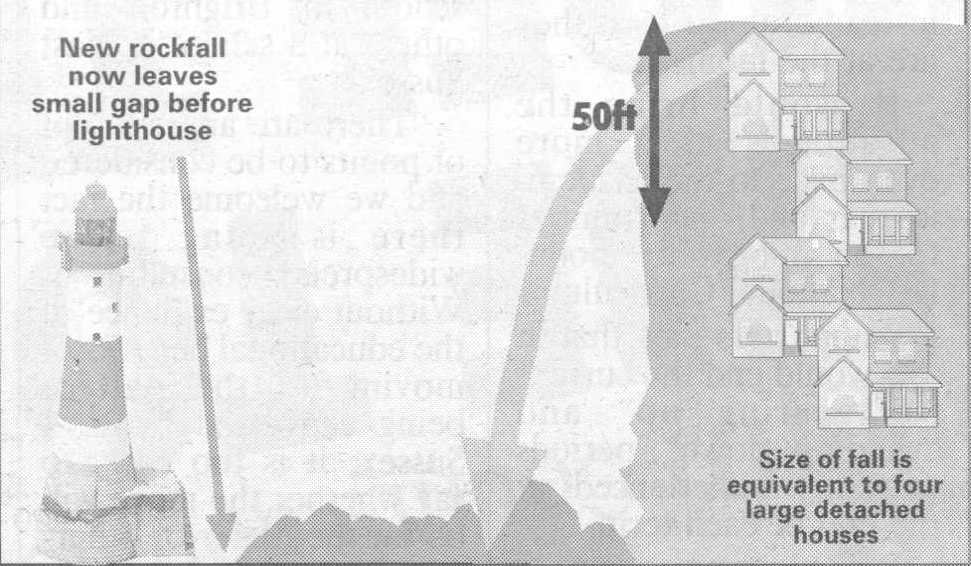 SAFETY experts were today monitoring the cliffs at Beachy Head after one of the biggest rockfalls in living memory. Thousands of tons of chalk fell 500ft onto the beach at the weekend and formed a mountain of rubble the size of four detached homes. The pile has blocked the sea channel between the world-famous Beachy Head lighthouse and the beach. Eastbourne lifeboatmen estimated that 50ft of the cliff face fell away along a 150-200 yard stretch.
SAFETY experts were today monitoring the cliffs at Beachy Head after one of the biggest rockfalls in living memory. Thousands of tons of chalk fell 500ft onto the beach at the weekend and formed a mountain of rubble the size of four detached homes. The pile has blocked the sea channel between the world-famous Beachy Head lighthouse and the beach. Eastbourne lifeboatmen estimated that 50ft of the cliff face fell away along a 150-200 yard stretch.
Now pleasure steamers which used to take sightseers between the lighthouse and the cliff during the summer have little chance of navigating what is left of the channel. Lifeboatman Keith Murphy said: "It is a very big cliff fall, the biggest one I've seen in 14 years." A spokesman for Dover Coastguard said it could have been caused by water getting into the chalk and freezing overnight, expanding joints in the rock and causing the cliff to crumble. He said: "From what I hear it is a major change to the coastline."
"I would advise people to stay away from the edge. "It only takes one slip and you don't get a second chance. "Walking along cliff edges is a dangerous occupation at the best of times." Mark Roberts, who lives at the nearby Belle Tout Lighthouse - itself in danger of falling into the sea - said the rockfall was "absolutely huge". He added: "It has connected the lighthouse back with the land." The clifftop Belle Tout lighthouse is due to be moved 50ft inland, probably on March 12, after a cliff collapse in November left it standing just l2ft from the abyss. "After seeing the latest slip at Beachy Head, Mark said: "I have asked the workmen to go just that little bit faster."
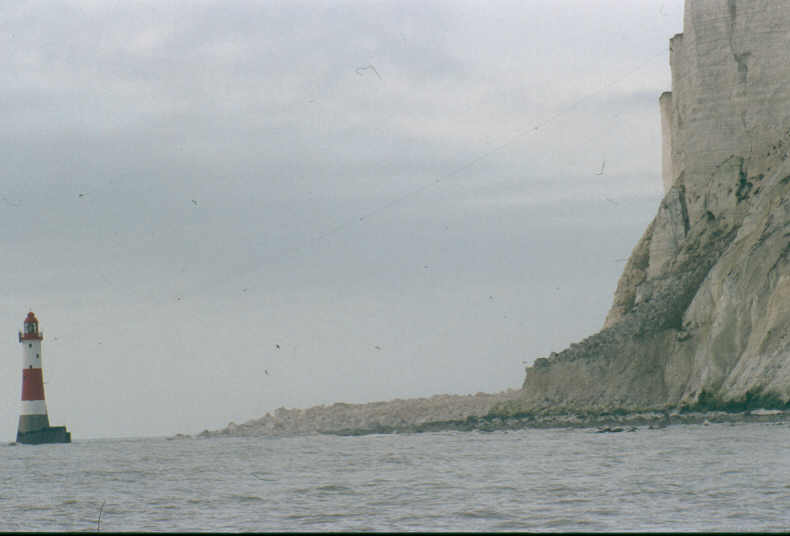
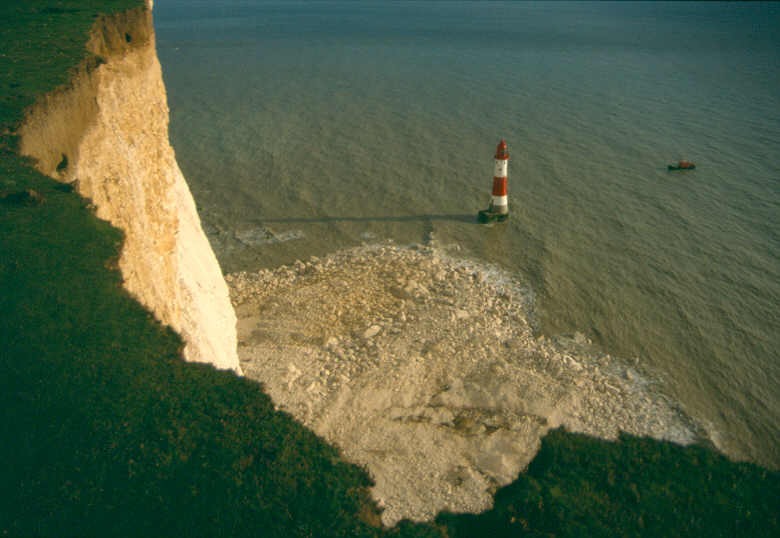
Images taken by D.R. Robinson in 1999
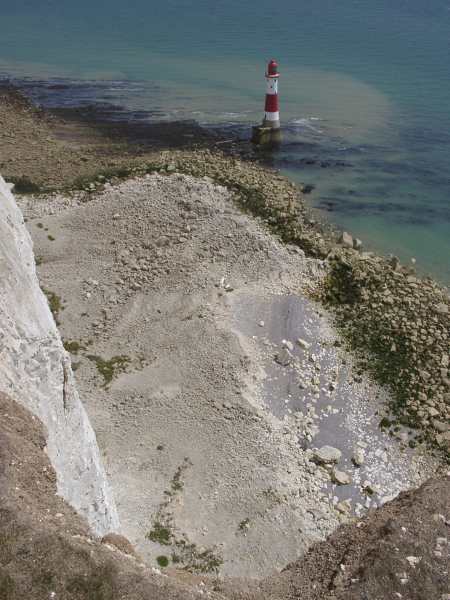 |
In July 2002 the cliff fall debris is still in place and only along the western side (right hand side of the image) changes can be seen where material has been removed and replaced by shingle. |
Beachy Head cliff crashes into the sea
The Times, 12 January 1999
by Helen Johnstone
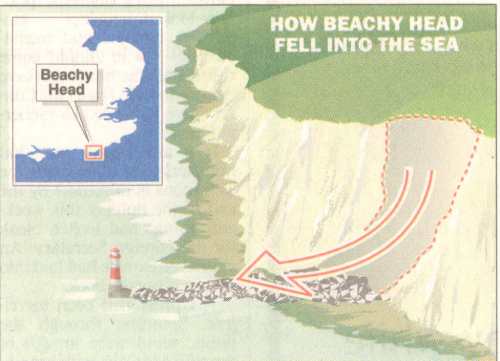 ,SAFETY experts were examining the coastal beauty spot at Beachy Head yesterday after a vast section of rockface crashed into the sea.
The unmanned Beachy Head lighthouse was effectively rejoined to the Sussex coast by thousands of tonnes of chalk fell which 500ft into the sea at the weekend, filling in a popular 100-yard sea channel used extensively by tourists.
Experts believe the collapse - probably the biggest single loss of coastline in living memory - to have been caused by water entering the chalk rock and expanding on freezing, forcing the cliff to crumble.
,SAFETY experts were examining the coastal beauty spot at Beachy Head yesterday after a vast section of rockface crashed into the sea.
The unmanned Beachy Head lighthouse was effectively rejoined to the Sussex coast by thousands of tonnes of chalk fell which 500ft into the sea at the weekend, filling in a popular 100-yard sea channel used extensively by tourists.
Experts believe the collapse - probably the biggest single loss of coastline in living memory - to have been caused by water entering the chalk rock and expanding on freezing, forcing the cliff to crumble.
Officials are constantly warning people to stand back from the edge of Beachy Head, which has the dubious distinction of being one of the world's most popular suicide spots, but yesterday coastguards were re-emphasising the dangers as council experts sought to establish how stable the remaining cliff face was. "It's a major change to the coastline," said one. "It only takes one slip and you don't get a second chance."
The landslide was spotted more than three miles out to sea by lifeboat crew members from Eastbourne who estimate that a 50ft deep slab of cliff face fell away along a 200-yard stretch.
Eddie Buckland, a lifeboatman, said: "It's colossal. It's fallen down right out to the lighthouse and up to near the top of the stairs. The last big fall was about 15 to 20 years ago at the nudist beach about 600 yards east. But that's tiny compared to this one. It's got to go out over 100 yards."
Mark Sawyer, 36, a fellow crewman, said: "I have never seen anything like this before, none of us have. We were three and a half miles out to sea when we saw it and we could see it clearly."
He added: "It really is massive. I've been with the lifeboat crew for eight years and I've been fishing there since I was eight years old and I've never seen a fall of that size."
The Environment Agency, which is not responsible for cliffs but is responsible for beaches, was keeping a close eye on Beachy Head after confirming the enormity of the collapse. Ray Kemp, for the agency, said it was the largest by far in the area and probably the largest yet in Britain.
"Hundreds upon thousands of tonnes have gone. Chunks have been falling off Beachy Head for ages but never anything like the size of this." He said wave height in the Atlantic had increased by 10 per cent in the past decade and the sea was hitting the coastline harder.
"One minute we are in a drought situation and then the chalk is sodden. In eight months out of twelve have had above average rainfall. The coastline is increasingly vulnerable as climate change starts to bite. What is happening is symptomatic of a whole range of circumstances. In my grandmother's time you could walk around Beachy Head, but that is impossible now."
The latest collapse provides fresh evidence of how many coastal landmarks and properties around Britain are under threat from coastal erosion. In 1994 Holbeck Hall Hotel in Scarborough fell into the North Sea, and ten villages along a 40-mile stretch of Humberside may have to be abandoned as the North Sea eats up the coastline at a rate of 11 yards a year.
Coastal erosion is also becoming a serious problem in eastern and southern England, with sea levels expected to rise by up to 20 inches over the next 50 years, while stormy seas have ravaged chalk cliffs along the South Downs coastline, leaving several homes perilously close to tumbling into the sea.
The erosion has accelerated work to save the neighbouring Belle Toute, Britain's only permanently inhabited former lighthouse. It was once 100ft from the cliff edge, but is now just 12ft away. It is due to be lifted on to rails that will push it back back 50ft and its owner said yesterday: "I have asked the workmen to go just that little bit faster."
Defences to protect famous coastline would mean THE WHITE CLIFFS ARE OVER
The Argus 13-01-1999
by TIM BOWDEN
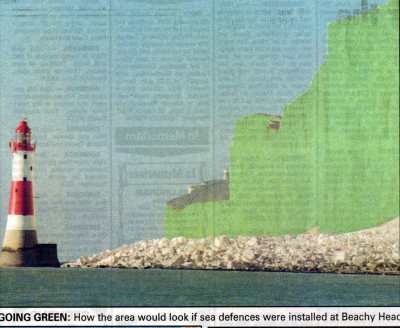 DEFENCES to protect erosion-hit Beachy Head would rob the landmark of its distinctive features - by turning the cliffs green. As the Argus revealed on Monday, thousands of tonnes of chalk fell 500ft on to the beach over the weekend. The fall, one of the biggest losses of British coastline in living memory, spills out 200ft into the sea and is the size of four detached houses. Homes in nearby Birling Gap are already threatened by erosion and residents want defences to protect them from further damage.
DEFENCES to protect erosion-hit Beachy Head would rob the landmark of its distinctive features - by turning the cliffs green. As the Argus revealed on Monday, thousands of tonnes of chalk fell 500ft on to the beach over the weekend. The fall, one of the biggest losses of British coastline in living memory, spills out 200ft into the sea and is the size of four detached houses. Homes in nearby Birling Gap are already threatened by erosion and residents want defences to protect them from further damage.
But efforts to stop further falls would change the area's famous white cliffs forever. A spokesman for the Environment Agency said any action would be based on a detailed cost-benefit analysis, taking into account homes and businesses affected by erosion. But he added: "Beachy Head is white because it erodes and exposes fresh chalk. "If defences were put in you would have a similar situation to Dover, where works for the Channel Tunnel mean the cliffs are now going green with vegetation." The rock fall, which has radically linked up Beachy Head lighthouse with the mainland, could become a permanent feature as Eastbourne Borough Council said it had no plans to remove the rubble.
Environment Agency flood defence team leader Rupert Clubb said any decision to install sea defences would be made by the local council. Plans would have to meet economic, technical and environmental criteria laid down by the Ministry of Agriculture, Fisheries and Food. Mr Clubb said: "We are working with local authorities to develop strategies for the whole Sussex coastline. "We are just starting a study of the area including Beachy Head. The aim is to develop a solution which will promote the natural environment. "Seeing man-made structures there might put people off visiting Beachy Head. Ultimately the decision lies with the local authority and the Ministry."
Eastbourne council has not taken a decision on installing sea defences and is taking part in the joint initiative to decide a course of action.
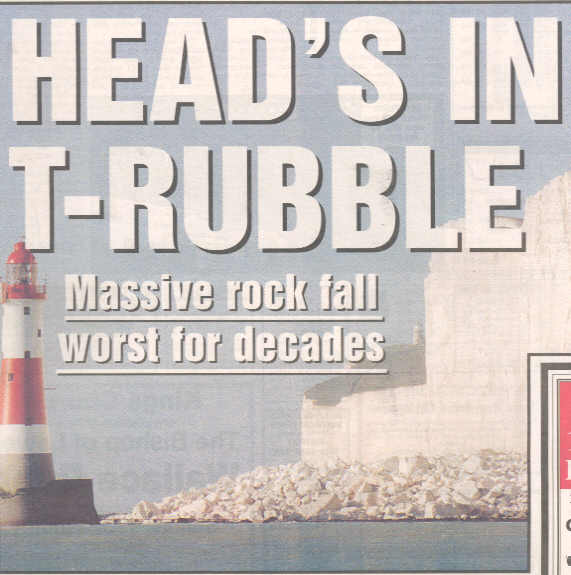
Head's in t-rubble
The Eastbourne Herald, 15-01-1999
by Laura Sonier
A MASSIVE rock fall at Beachy Head on Sunday caused thousands of tonnes of chalk to crash down on the beach. The rock fell 500ft onto the shingle below creating a pile the size of four large detached houses - and Dover coastguards have advised walkers to stay away from the edge.
The chalk has almost filled in the channel between the beach and the town's famous Beachy Head lighthouse, narrowing the distance from 300ft to only 100ft. The huge fall raises fears for the Belle Tout lighthouse which is currently being moved away from the perilous cliff edge. Eastbourne lifeboat crews - who have seen the chalk close-up - estimate as much as 50ft of rock fell a way over 150-200 yards. And it is believed the fall was caused by water seeping into the cliff, freezing and expanding - then shattering the rock.
Eastbourne Borough Council officers were on the scene just minutes after the fall to inspect the cliff. 'The chalk fall took place in an area that was previously fenced off,' explained an Eastbourne Borough Council spokeswoman. 'There are still 20 metres of cliff between the fence and the cliff edge. 'We were notified on Sunday at 11.30am and were on the site at 11.45am.' The spokeswoman agreed a massive fall had occurred and added that falls happen 'all the time' at cliffs around the country. 'This is a natural process exacerbated by the recent rainy spell followed by a frost,' she explained. 'Cliff erosion happens all along the British coastline and it is beyond our control.'
Rock fall will turn sea white
The Argus, 17-01-1999
by JUSTIN PARKINSON
EXPERTS are warning that the sea off Eastbourne could turn white this summer following the biggest rockfall in living memory. Last Monday, the Argus exclusively revealed how thousands of tons of chalk had collapsed on to the beach at Beachy Head, almost joining the world-famous lighthouse to the land. Now the Environment Agency has warned that the sea will break down the chalk, which could form a huge white streak through the English Channel. It is feared some of the cloudy water will colour Eastbourne's bathing beaches if storms hit the area.
A spokesman for Dover coastguard said: "We normally get only a couple of tons at a time falling into the sea. Even that turns the sea visibly white for a while. "A fall of this size could mean milky coloured water hanging around for a couple of weeks. "It could be very noticeable in Eastbourne." Environment Agency spokesman Anthony Field said: "It wouldn't happen overnight. But it will break down because chalk is one of the softer rocks. "If we have rough seas this will accentuate the process.
"There will be more chalk in the sea because of the breakdown. Some of it will dissolve chemically but much more will be broken down by bad weather. "It will travel from west to east with the prevailing tides." Eastbourne Council's head of leisure, Diane Bagley, said: "We think the effect on local people will be negligible."
On Thursday the Argus reported how the famous cliffs at Beachy Head could turn green if proposed sea defences reduce the exposure of the chalk to the effects of the sea. Experts said the cliffs would become more stable, allowing vegetation to grow.
What a cliffhanger! Erosion is changing our coastline but should we worry about it ?
The Guardian 19-01-1999
by Emily Moore
Earlier this month a large section of Beachy Head, a cliff on the south coast of England, collapsed into the sea. Some experts fear that other parts of the English coastline will soon be taking a tumble. But others say changes in our coastline are natural and not a cause for concern.
How serious was the collapse at Beachy Head?
It was the largest single loss of coastline in living memory. A 15m x 60m section of the chalk cliff crashed into the sea -that is hundreds of thousands of tonnes of chalk.
What caused the collapse?
Experts think the weather played the most important part, but rough seas, rising sea levels, and the fact that Britain is naturally tilting were also important. The south of England had been very dry for 30 months until last year, when eight out of the 12 months had above-average rainfall. This meant the chalk cliffs of Beachy Head first dried out and became brittle, and then, when the rainy period started, became water-logged and soggy. Cold weather at the beginning of January meant the water in the rock froze. When water freezes it expands, and this forced the cliff to crumble. Waves also played a large part in eroding the cliff. Erosion (from the Latin erosio, which means "gnaw") is when rocks are slowly worn away by the action of water, ice and wind. It is usually a slow process, but over the past few weeks the waves have been rough and strong on the south coast. Sea levels seem to be rising. Over the next 50 years sea levels are expected to rise over 20cm. The countries of the world are constantly (very, very slowly!) on the move. Britain is tilting, with Scotland rising and the south of England sinking.
Is there a reason for this weather and the rise in sealevel?
Yes. Many experts believe both have been caused by global warming, known as the Greenhouse Effect. This is caused by gases released into the atmosphere, mostly by burning fossil fuels and cutting down trees. The planet does seem to be warming up and weather patterns changing. As a result, glaciers are starting to melt, causing sea levels to rise. Are other parts of the coastline at risk of collapse? Yes. The most vulnerable are stretches of the east and south coast. Holderness in Yorkshire, Lyme Regis in Dorset and part of the cliffs on the Isle of Wight are among those at greatest risk.
How can the coastline be protected?
The most common ways are to erect shingle embankments, or wooden or rock beach defences called grovnes, which soften the impact of waves. But some people want to take tougher measures and build concrete structures to protect the coast.
Does everyone agree?
No. Other experts are keen to point out that coastal erosion is a natural process and has always happened - it has helped to shape the coastline we love. The reason the famous White Cliffs of Dover are so white and bright is because they are pounded by the sea. If they were protected they would be covered by vegetation and become the Green Cliffs of Dover instead! For millions of years we have been losing cliffs - but at the same time gaining new beaches. Areas of our coastline most vulnerable to wave and weather erosion are also often the perfect places for fossil hunting, because the waves keep washing away the rock. Last summer on the Isle of Wight, 12-year-old Paul Mike found a fossil of a 40 million-year-old crocodile (called a diplocynodon) - the oldest found in Britain.
The wave action had washed away layers that had taken millions of years to build up over the dead crocodile's fossilised skeleton. If you take a walk along the coast at Lyme Regis you may find fossilised ammonites - these are ancient shellfish related to the squid. Without coastal erosion these fossils would still be buried in the rock.
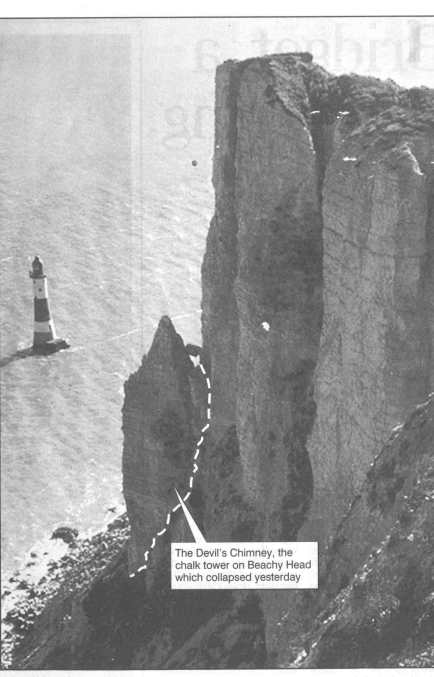
Cold, wet winter blamed for cliff collapse at Beachy Head
The Independent 04-05-2001
by MICHAEL MCCARTHY
A COASTAL landmark has disappeared in a spectacular rock fall, shrinking southern England's most famous cliffs for the second time in little more than two years.
An outcrop of the cliffs at Beachy Head, near Eastbourne in Sussex, fell into the sea on Tuesday. The 200ft-high chalk tower, known locally as the Devil's Chimney sent thousands of tons of rubble crashing on to the rocks below when it suddenly disintegrated. No one was hurt in the fall.
An even larger section of the cliffs nearby, 200 yards long, crashed down the full 500ft to the sea without warning in January 1999, in an incident that was blamed on global warming by the Environment Agency- an increase in stormy weather caused by climate change was the probable cause, the agency saki That was probably the biggest cliff fall in Britain for many years.
This week's collapse is being blamed more directly on the winter's unprecedented rain, which has seeped into cracks in the chalk and then frozen in cold weather, causing it to crack.
It is one of a series, and appears to be remarkably similar to the collapse in January this year of a 100,000-ton chalk section of the White Cliffs of Dover,
as a big as a football pitch, which fell 300 feet to the sea at a point between Dover and St Margaret's Bay
Beachy Head, west of Eastbourne, where the South Downs come down to the sea, is a popular beauty spot normally visited by more than a million people a year- and also frequently used for suicides. There has not been a severe erosion problem with the cliffs until recent years.
Eastbourne council urged people to stay away from them yesterday because of the foot-and-mouth disease outbreak. The South Downs are closed to the public as a precaution against the disease spreading to the area's wildlife.
Walkers were also advised not to try to get into the area along the beach, an arduous
three-hour hike from Eastbourne across large rocks.
"Natural phenomena like this do fall down over time due to weathering and erosion," said Graham Marsden, the leader of Eastbourne council. "But it is a sad day when nature claims back part of a beauty spot. This is a reminder of the natural instability of cliffs and the importance of staying away from directly beneath the cliff edge."
The Devil's Chimney stood 30ft from the cliff edge. Members of the public had reported seeing big cracks appear in recent days.
The collapse brought out some unconventional responses. A local "white witch" planned a "cleansing ceremony" near the cliffs yesterday after news that the late occultist Aleister Crowley, famed for practising black magic in the Twenties, had climbed the chalk tower in 1894.
It is claimed he predicted an evil spell would fall on the people of Eastbourne if the tower ever collapsed. Now, Kevin Carlyon, who says he is a High Priest in the Coven of White Witches, is to conduct a ceremony to "dispel any evil.
"It seems Beachy Head has not had much luck over the centuries." he said. "It is written that a monk was thrown from the top in AD520 and, of course, many people commit suicide there each year.
"It also has this association with Aleister Crowley so I shall carry out a cleansing ceremony in case."
The following external link will get you to the Beach Head rock fall pages of the British Geological Survey including a critical appraisal of the causes, photos and a geological sketch map of Beachy Head.


 SAFETY experts were today monitoring the cliffs at Beachy Head after one of the biggest rockfalls in living memory. Thousands of tons of chalk fell 500ft onto the beach at the weekend and formed a mountain of rubble the size of four detached homes. The pile has blocked the sea channel between the world-famous Beachy Head lighthouse and the beach. Eastbourne lifeboatmen estimated that 50ft of the cliff face fell away along a 150-200 yard stretch.
SAFETY experts were today monitoring the cliffs at Beachy Head after one of the biggest rockfalls in living memory. Thousands of tons of chalk fell 500ft onto the beach at the weekend and formed a mountain of rubble the size of four detached homes. The pile has blocked the sea channel between the world-famous Beachy Head lighthouse and the beach. Eastbourne lifeboatmen estimated that 50ft of the cliff face fell away along a 150-200 yard stretch.


 ,SAFETY experts were examining the coastal beauty spot at Beachy Head yesterday after a vast section of rockface crashed into the sea.
The unmanned Beachy Head lighthouse was effectively rejoined to the Sussex coast by thousands of tonnes of chalk fell which 500ft into the sea at the weekend, filling in a popular 100-yard sea channel used extensively by tourists.
Experts believe the collapse - probably the biggest single loss of coastline in living memory - to have been caused by water entering the chalk rock and expanding on freezing, forcing the cliff to crumble.
,SAFETY experts were examining the coastal beauty spot at Beachy Head yesterday after a vast section of rockface crashed into the sea.
The unmanned Beachy Head lighthouse was effectively rejoined to the Sussex coast by thousands of tonnes of chalk fell which 500ft into the sea at the weekend, filling in a popular 100-yard sea channel used extensively by tourists.
Experts believe the collapse - probably the biggest single loss of coastline in living memory - to have been caused by water entering the chalk rock and expanding on freezing, forcing the cliff to crumble. DEFENCES to protect erosion-hit Beachy Head would rob the landmark of its distinctive features - by turning the cliffs green. As the Argus revealed on Monday, thousands of tonnes of chalk fell 500ft on to the beach over the weekend. The fall, one of the biggest losses of British coastline in living memory, spills out 200ft into the sea and is the size of four detached houses. Homes in nearby Birling Gap are already threatened by erosion and residents want defences to protect them from further damage.
DEFENCES to protect erosion-hit Beachy Head would rob the landmark of its distinctive features - by turning the cliffs green. As the Argus revealed on Monday, thousands of tonnes of chalk fell 500ft on to the beach over the weekend. The fall, one of the biggest losses of British coastline in living memory, spills out 200ft into the sea and is the size of four detached houses. Homes in nearby Birling Gap are already threatened by erosion and residents want defences to protect them from further damage.
